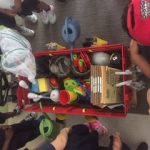This project was designed to meet the needs of our early years students (kindergarten) through the development and effective use of an integrated outdoor learning environment. As a kindergarten team, we sought to gain an understanding of how to best utilize our kindergarten outdoor play space to promote student inquiry and exploratory opportunities in an outdoor setting. We provided greater opportunities for students to build a relationship with their natural surroundings by creating an outdoor learning space that would meet the needs of all of our young learners.
Team Members
Alison Morawek
Niagara Catholic District School Board
Amy Tiller
Niagara Catholic District School Board
Kelly Doherty
Niagara Catholic District School Board
Professional Learning Goals
- Built upon our current instructional practices in the areas of outdoor education and inquiry-based learning to support students’ interests and play experiences
- Developed a series of strategies that assisted us in “provoking” and assessing student inquiry and learning in a natural, outdoor setting
- Designed and provided an outdoor learning space for students
Activities and Resources
We purchased and filled a Wonder Wagon to encourage students to explore mathematical concepts (e.g., patterns in nature) and literacy skills (oral and written communication), based on observations and experiences within their natural surroundings. Students were given access to materials housed in the Wonder Wagon (e.g., magnifying glasses, butterfly nets, tweezers) to collect and study natural materials, in order to enhance their understanding of science concepts.
We also planned and implemented two Outdoor Education Days that incorporated the use of our enhanced outdoor play space, as well as materials within the Wonder Wagon. Examples of activities held on these days were:
- Cloud watching and accompanying art activity
- Outdoor scavenger hunt (using iPads to document findings)
- Literacy and numeracy activities using natural, loose parts (e.g., pine cones, twigs, stones, acorns, etc.)
Unexpected Challenges
The unanticipated cost of various structures that we wished to include in our outdoor play space was definitely a challenge. Therefore, we elicited the help of our feeder high school’s woodworking department to build our mud kitchen, herb garden stand and outdoor sensory table for a fraction of the cost that we would pay had we ordered these from a catalogue. Having said that, a second challenge was the amount of time that was taken to have these structures built, delivered, and set up for student use in our outdoor play space.
Enhancing Student Learning and Development
This project provided greater opportunities for children to play, inquire and explore in a natural outdoor setting. It is hoped that these opportunities will help to enhance children’s physical, social and emotional development. Providing richer opportunities for outdoor play will also help to build students’ self-esteem, resilience, confidence, perseverance and creativity. Finally, through the establishment of additional natural features in our outdoor play space (i.e., mud kitchen, herb garden, outdoor sand/sensory table), students are now afforded greater variety in the types of play and inquiry that are available to them.
Sharing
The learning gleaned from this project will be shared with other kindergarten teachers within our school board, as determined by school- and board-level administration. This may include a presentation of our strategies and findings at a school- or board-wide PA Day for elementary teachers and ECEs. After-school workshops might also be offered to kindergarten teams as a way of presenting our findings. We may also hold a Parent Information Session to inform the community at large of our findings, including strategies that can be implemented outside of a school setting, to encourage students to explore and play in their outdoor surroundings on a daily basis.
Project Evaluation
We feel that overall this project was a success in so far as we were able to utilize funds to construct and purchase items for our outdoor play space that would hopefully enhance students’ exploration opportunities in a natural setting. However, it took a considerable amount of time for the mud kitchen, herb garden stand and outdoor sensory table to be constructed by the woodworking department at our feeder high school. Therefore we won’t have much opportunity to utilize these items and to assess their impact on student engagement and inquiry until the autumn. We have been able to set up our Wonder Wagon with a plethora of tools that students can access to explore in and around our small green space at the side of the school. Materials such as insect finders, binoculars, measuring tapes, tweezers and butterfly nets have been a huge success with the students as they investigate different ways of using these items to explore their natural outdoor surroundings. We believe that once we have the remainder of our structures and materials in place in the autumn, then we will be able to better “provoke” and assess student inquiry as part of their outdoor exploration opportunities.
Resources Used
Natural Curiosity: Building Children’s Understanding of the World Through Environmental Inquiry
http://www.naturalcuriosity.ca/pdf/NaturalCuriosityManual.pdf
Resources Created
These resources will open in your browser in a new tab, or be downloaded to your computer.



